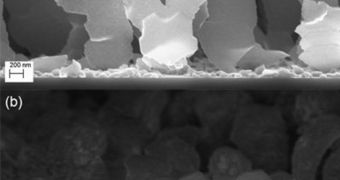Efforts to create working hydrogen cars have largely failed due to the fact that there are not real options when it comes to storing the chemical for prolonged use. Now, investigators in the United States have developed a new nanomaterial that they believe might be able to solve this predicament.
This novel material is made up of nanoblades, structures at the nanoscale that are many times smaller than the width of a human hair. According to experts at the Rensselaer Polytechnic Institute (RPI), these formations can be used to improve hydrogen storage several times over current capabilities.
The attribute that makes all the difference between nanoblades and other nanomaterials is that the former is rechargeable, while also able to store and release its hydrogen payload at very high speeds and low temperatures. These properties make it desirable for a large number of potential applications.
Details of the study – which was carried out with funds from the US National Science Foundation (NSF) – appear in a paper called “Low-temperature cycling of hydrogenation-dehydrogenation of Pd-decorated Mg nanoblades.”
The work is published in the September issue of the esteemed International Journal of Hydrogen Energy, and is based on magnesium nanoblades first created at RPI back in 2007. What separates these structures from nanorods and nanosprings is the fact that they are asymmetrical.
Due to this property, each of their dimensions is considerably wider or thinner than the other one, with the desired effect of producing a massive surface area for such a small particle. When put together, each of the particles is separated from the other by at least a micron, which is a lot at the nanoscale.
“The requirements from the Department of Energy are very challenging for existing hydrogen storage technology, particularly when it comes to new energy storage materials for onboard hydrogen storage,” postdoctoral Yu Liu says. He was the lead author of the study.
“All new materials must operate at low temperatures, desorb hydrogen quickly, be cost efficient, and be recyclable,” he goes on to say. He and RPI professor of physics, applied physics, and astronomy Gwo-Ching Wang believe the nanoblades meet all these requirements.
But experts are aware that still many difficult challenges lie ahead. Want says that the nanoblades can now undergo a cycle of 10 charges and discharges before becoming useless. “The next steps are to improve recyclability,” he explains.
“We have found the root cause of the degradation of the material; now we can begin to improve the material,” the researcher details. By making the nanoblades capable of undergoing more charge/recharge cycles, the experts could set the basis of a global, hydrogen-powered infrastructure.

 14 DAY TRIAL //
14 DAY TRIAL //